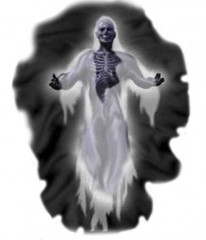Hungry Ghosts
 We all like a bit of a scare. As children we’ve gathered under blankets with flashlights and spooked each other with ghost stories. Even while in diapers and growing sea legs we threw on a sheet and screamed “Boo!” As far back in human history fairytales have been scary. On All Saints Day we satiate the desire to scare and be scared. At other times we indulge in films like The Shining. There’s nothing like a good scare!
We all like a bit of a scare. As children we’ve gathered under blankets with flashlights and spooked each other with ghost stories. Even while in diapers and growing sea legs we threw on a sheet and screamed “Boo!” As far back in human history fairytales have been scary. On All Saints Day we satiate the desire to scare and be scared. At other times we indulge in films like The Shining. There’s nothing like a good scare!
This strange enjoyment comes from the primal nature of fear. Probing the hidden part of us that lives in fear has always been an important human experience. As the author Lovecraft wrote, “The oldest and strongest emotion of mankind is fear and the oldest and strongest kind of fear is fear of the unknown.” Ghosts are the embodiment of this fear and since imagination is part of being scared, ghosts can be whatever we want them to be.
One definition of a ghost is someone who hasn’t quite made it. They died, but don’t know that yet, so they wander in a confused state. Regardless, whether they’re malevolent or benevolent, ghosts are the principle of life: the spirit of a departed person.
In Buddhism they’re called “Hungry Ghosts” and are portrayed with a large belly and a very skinny throat. They want to eat and feel full, but cannot. No matter what they eat or how much, they’re always hungry. They didn’t adequately provide themselves with what they needed to flourish in the afterlife.
The Zen Master, Thich Nhat Hanh uses the Hungry Ghost to describe a psychological condition that plagues many. When there’s a disconnection from our source of life, we begin to wither and become a hungry ghost, wandering and looking for something to revive us.
As much as we like to be scared, we also enjoy a good laugh. Ghost stories and jokes are similar—both lead up to the point where either you laugh or shiver!